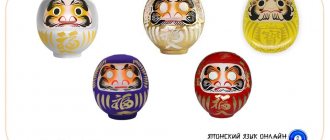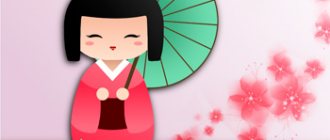Japanese Daruma
This is a simple-looking toy, round like a bun, has the properties of a tumbler and... works wonders. Well, that’s what is commonly believed, at least))) And for a miracle, all you need to do on New Year’s is make a wish and draw one eye for her. And when your wish comes true, don’t forget to draw a second one, otherwise the magic won’t work anymore.
Daruma is a shortened Japanese name for Bodaidaruma, Bodhidharma, the founder of the Zen school of Buddhism in the 5th and 6th centuries.
According to legend, after meditating for 9 years, Bodaidaruma wanted to get up, but fell, as his limbs and muscles atrophied. Well, here is the doll - without arms, without legs, falls, but rises again. And for these reasons, the Daruma doll, as you already understand, symbolizes perseverance and determination. Next to the doll you can see the following slogan: nanakorobi yaoki 七転八起 - fell seven times, rose eight. This phrase is symbolic, since every time a person rises after a fall, he strives to become better. Well, in reality, for example, during the Edo period, when the tradition came to associate the fulfillment of one’s desires with the acquisition of a doll, there were many outbreaks of smallpox and measles. And according to legend, if a child fell ill in the house, it was necessary to stretch ropes around the house with red paper strips strung on it, dress the child in a red robe and make a small altar for God and put a talisman there - Daruma. The figure was used to appease God and encourage the sick person to recover quickly.
As a rule, Daruma is made of wood or papier-mâché. The choice of material is determined by the fact that it is customary to burn dolls if a wish is not fulfilled. This is done in the temple according to a special ritual. All Daruma dolls that have not been granted a wish in the current year are brought to the temple (once a year) for a traditional burning ceremony called Daruma Kuyo, which takes place in the first days after the New Year.
Having expressed his gratitude to Daruma, the owner gives it to the temple and after 24 hours of reading sutras, a festival procession of children, and a solemn performance by monks, tens of thousands of Daruma figurines are set on fire.
Daruma's face carries a certain meaning and interpretation: the beard is made in the shape of a turtle, which lives for 10,000 years and symbolizes longevity; on the sides and belly of the doll there are other spells - for good luck, good business and long family relationships.
Traditionally, the Daruma doll is made in red, but other colors can be seen. So, for example, if you make a wish for love, you can buy a pink doll, wealth and money - yellow, health - green, there is also a golden Daruma doll, which brings good luck in financial matters. The white doll is a talisman in the silk industry and healthy child rearing, popular in Daruma in Yamanashi Prefecture.
As soon as Daruma falls into your hands, you should do the following:
Step 1 – Determine the specific goal you intend to achieve.
Step 2 - Paint over one of the eyes (it doesn't matter whether it's left or right) to show your desire to achieve your goal.
Step 3 - Place the doll in a prominent place in the house so that while Daruma is focusing on your goal, you will not stop thinking about it and going towards it.
Step 4 – once the goal is achieved (and this is exactly what it will be), complete Daruma’s second eye, this way you say “Thank you!” to her!
Step 5 – Write the achieved goal on Daruma's back.
What's next? And then you need to buy a new Daruma doll, preferably a larger one, and fulfill your next wish!)
Keep in mind that success comes only with clear and correct goal setting!
The key to success is a clear vision of what you want, focus on results and determination that will not allow you to deviate from your plans. Daruma is the embodiment of your specific goal. And at the same time, the doll is a reminder that once you have set out on the road to achieving your goal, you will never turn back! The wishes made must be measurable, that is, have a deadline for fulfillment. The ideal period for fulfilling a wish is 1 year. For Daruma to work, you need to remember the following: you can purchase a doll only once a year and, accordingly, make only one wish; Having bought a doll, you need to draw one eye for it; the desire should not seem impossible or immodest; it is better to take small steps to achieve great success; if the wish does not come true, the doll is burned in the temple where it was purchased; for this, the temple seal is placed on the dolls. In general, if the temple seal is not in place, then your Daruma will not work)
In Japan, there is an adult approach to dolls. For example, Daruma is widely used by politicians who have started an election campaign: they buy a Daruma doll, draw one eye on it, making a wish to win the elections, and finish drawing the second eye after the elections. But now this is not advertised, since this ritual was considered incorrect in relation to the blind.
The first mention of the use of a doll in an election campaign dates back to 1928. In 1930, in the city of Nagano, Mr. Matsumoto took Daruma as his assistant and, as a result, won the elections, this became the basis of today’s tradition among politicians. Today, 2.5 million figures are sold per year in Japan. More than 100 families in Takasaki continue the tradition of their ancestors by making Daruma dolls to sell at the fair. Not only Japanese, but also foreign tourists come to Takasaki to buy a doll. Materials from the sites ***https://tensaigakkou.ru/kukla-daruma-kak-zagadat-zhelanie/*** ***https://orient-gift.ru/interesnoe/22-osobennost-kukly-daruma were used. html***
See more collectible dolls in themes on Babyki.
Who invented the matryoshka doll?
The Russian nesting doll was “born” at the end of the 19th century thanks to Sergei Malyutin. The artist, in love with Russian art, spotted an interesting concept from Japanese masters - a toy consisting of eight copies. Malyutin Russified the idea. So, the Japanese elder was replaced by a portly young lady with rosy cheeks. A few years later, the toy was turned out by the talented turner Sergei Zvezdochkin based on Malyutin’s sketches.
Malyutin didn’t just turn a nesting doll into a woman. The first toys did not include eight identical copies, but children - boys and girls with different appearances. The last, non-demountable part is a baby in diapers. Thus, the first nesting doll was the mother of a large family. Hence the name. Matryona is a common female name at that time, which comes from the word “mother”.
Why traditional dolls are becoming less popular in Japan
Traditional art is not accessible to everyone. Ancient rich clans have a wide variety of household items - including various dolls. Ordinary Japanese, coming from poor families, live in small city apartments and do not have enough space to organize a doll corner. Since real works of art are expensive, not everyone can buy them for themselves. Difficulty of access makes classic dolls less and less popular. At the same time, the pace of life is accelerating, people have less time for traditional holidays and festivals, preparing for them, admiring the beauty of the world around them. This also plays a role in the gradual forgetting of ancient traditions.
Vanka-Vstanka
But in Russia this doll has its own name - Vanka-Vstanka. Theoretically, the name comes from “Get up, Vanya” - a phrase that was used to raise soldiers on a campaign in the tsarist army under Catherine II. The principle of the doll's structure is the same - it is a kind of vessel in which a sinker is attached. It is located in the center and prevents the toy from turning over, no matter how it swings.
In Russia, Vanka-Vstanka appeared about 200 years ago, just like in China, but had a different name - “Shut up, baby.” They were sold at fairs and they had a buffoonish appearance - thus people ridiculed the fat-bellied merchants. Each doll was decorated in the Russian national style, but at the same time had a distinctive feature. Mostly toys were made in Nizhny Novgorod from wood. The most commonly used wood was pine, linden and aspen. Such toys were passed down from generation to generation and served as a talisman for the home.
Found a violation? Report content
Tumbler in the foreign press
Foreigners believe that the tumbler is rooted in Russian culture, but this is not entirely true. It has its roots in an unknown place, and historians cannot give a clear answer to this question. The first dolls in the image of the Russian nesting doll are attributed to the Chinese and Japanese, but this is an unproven fact. Somehow it so happened that foreigners still consider this toy to be Russian and sell it in Russian souvenir shops. The name of the doll is interpreted in different ways, but its main definitions are considered to be hardness and steadfastness. Tumbler defines a person who is not easily blamed by various circumstances or adversity.
How to wash away trouble?
However, a major deliverance from the defilement and sins of the past year using paper images of a person took place in Shinto shrines on New Year's Eve. The figurines sold the day before for a small fee (according to the number of family members) were burned or thrown into a mountain river after the priest performed the Prayer Book of the Great Cleansing. Dolls floating with the flow were called nagashibina. According to legend, all the troubles and misfortunes that threatened a person went away with them. On the first day of the Snake, on the third moon (according to the lunar calendar), the Rite of Purification took place. On this day, people went to the river bank and let paper dolls float downstream, which they had previously applied to their bodies. There were dolls that controlled the weather. A ball of wood, cotton wool or crumpled paper was wrapped in a piece of cloth and tied with thread. The result was a head with a skirt. On the head, sometimes eyes and a mouth were drawn. Such a doll was hung at the entrance to the house or at the window to ensure good weather the next day. In the Shinto magical rite, there were wooden dolls, with the help of which the will of the gods was revealed to people. The mediators in this case were priestesses - miko, endowed, as it was believed, with an extraordinary gift from above to revive dolls. Miko, while casting spells, not only held a wooden figurine in front of her, she moved it so deftly that she made the audience believe that she had actually come to life.
Story
Archaeological research has uncovered traditional toys dating back to the Jomon era. These ninges were used as talismans and served as personal and household amulets. Along with the development of society, ideas about the beauty and purpose of toys have transformed. Interest in ninga peaked during the Edo era. At the same time, many new forms and purposes appeared. In 1936, the production of classic toys became an official genre of art. Since 1954, every spring an award ceremony has been organized to award the title of Japan's Living National Treasure to the country's best puppeteer.
Ningyo - Japanese art
Japanese dolls are made from fabric, clay, paper, wood, and fresh flowers. In the past, it was believed that such objects had a soul, were capable of coming to life, acquiring a human soul. The legend is associated with long-standing ideas that strong human love can breathe life into an object that visually resembles a person or animal. The historical context and subsequent recognition of toy making as an art have led to the fact that the Land of the Rising Sun is now sometimes referred to as the Land of 10,000 Dolls. These toys form an aesthetic, mystical world with its own religion and laws. In modern Japanese history, ninge is an entertainment for adults, not children.
Ninge – a toy for adults
Legends of dolls: the tale of Tanabata
Japan is a country whose residents call the Milky Way the Great Heavenly River. They believe that it did not always exist; in the past, the entire celestial plain could be crossed in any direction. Exactly in the center stood a beautiful palace surrounded by gardens. The charming Orihime lived in the female half, weaving fabric for the heavenly veil without pause. Thanks to her work, it was clear at night and the sun was visible in the sky during the day. The male half was inhabited by Hikoboshi, the shepherd of the heavenly flock. Together they created an incredible cycle of days and nights. The divine host appreciated their efforts and decided to marry the couple. Hikoboshi, seeing Orihime for the first time, realized that he had never met such a beautiful maiden, and she realized that there was and would not be another person capable of exciting her soul as much as Hikoboshi. Even a momentary separation was a difficult ordeal for the newly-made spouses.
Ninghe legends reflect
The couple was so carried away by each other that the heavenly flocks were left unattended, the loom gathered dust in the chambers. The nights became dark and people suffered, and the mountains groaned, causing fear among people. Seeing no other solution, Amaterasu decided to separate the couple and separated them by the Milky Way. Orihime, returning to weaving, burst into tears, causing the fabric to become dull and uneven. With her tears, the river spread wider and wider. Hikoboshi was also sad, his herds were thinning. It began to rain endlessly on the ground, and the mournful wind echoed the flute.
Tanabata dolls
The sight of those suffering resonated in Amaterasu’s soul, and the goddess softened her anger. Once she caught a magpie, with which the couple were sending messages to each other, and ordered it to create a bridge every week so that the couple could meet. The bird got everything mixed up, so the magpies create a bridge only once a year. This day is Tanabata, one of the largest Japanese festivals. The holiday is associated with hopes, love, faith and the fulfillment of desires. Paper ones hang in the windows of houses, symbolizing the heavenly couple. These ninge are the main traditional decoration of the festival.
Tanabata
Daruma
A special type of Japanese dolls are mystical, ritual Daruma. Their story is connected with Bodhidharma - he meditated for so long that it was as if he had turned into a doll. The Japanese pronounce Bodhidharma's name as Bodaidaruma. The teacher died in 528, and after his death he was recognized as a deity. Followers of Zen Buddhism made a tumbler doll, naming it after the saint. The name has been simplified a little so that children and adults from any part of the country can quickly remember it. This is how Daruma appeared.
Daruma
Hinamatsuri
The history of ninge is incomplete without a story about Hinamatsuri - the girls' holiday. For modern people, toys are objects of entertainment and souvenirs, but in the past in Japan they were important decorations and valuable objects of art. Shogun Tokugawa Yoshimune had a large family in the 18th century, and the ruler had especially many daughters. Each girl had her own dolls, which they showed off to others. This is how the ceremony of the puppet exhibition began. They began to collect toys representing the Imperial Court. For demonstration, the dolls were placed on stands of 3-7 tiers. The shelves were covered in scarlet fabric and the dolls were dressed in detailed dresses. They were lined up in accordance with the hierarchy of the court: a couple was seated at the top, symbolizing the ruling spouses, courtiers, samurai and musicians were placed below, and utensils and interior items were placed on the lower tier. Such exhibitions are still held today. They begin in February and last until early March, ending simultaneously with Hinamatsuri - the festival is held on March 3.
Ninge
Okiku
The story about Okika inspired writers, directors, and theater directors. In 1918, an exhibition of overseas goods was organized in Sapporo. Among the visitors was a boy, Suzuki Eikichi. He bought Okika for his two-year-old sister. The gift made the baby very happy, she gave her a name and spent all her time with her. A year later she became seriously ill and died. The family was plunged into grief. At home, we created an altar to Okiku and placed our daughter’s favorite toy on it. Every day the elders offered prayers at the altar and soon noticed that the doll was growing hair. They realized that the child's soul had moved into the doll, and gave the item to the local temple. Soon the monks noted the growth of the hair and cut it for the first time when the length reached 25 cm. Later they found out that the growth rate of the doll's hair corresponded to that of a three-year-old child.
Okiku
Rite of purification
The ancient Japanese believed that dolls had many mystical powers. In particular, they can help get rid of ailments and all kinds of troubles. This belief was closely related to the ritual of purification (oharai), widespread in the Land of the Rising Sun. For example, in order to cure a child, on the third day of the lunar month it is necessary to make a paper doll (boy or girl), then rub the figurine on the patient’s body, and then throw the doll into the river or burn it. With the arrival of spring, illnesses associated with this treacherous time of year also appeared. To save the family from illness, in the very first days of spring, straw dolls were made (according to the number of people living in the house), which, together with ritual cakes (dango), were hung on a tree at the entrance to the home.








